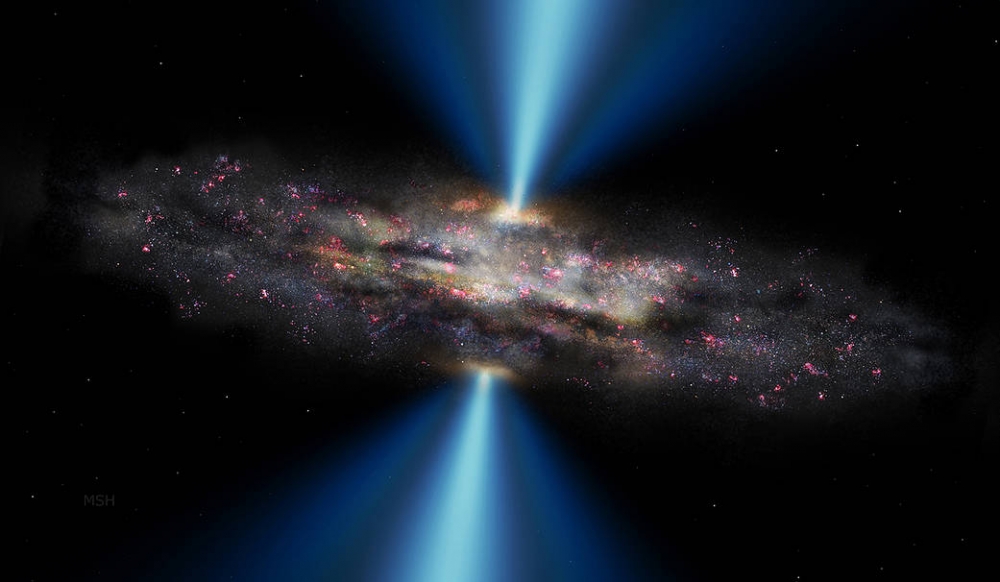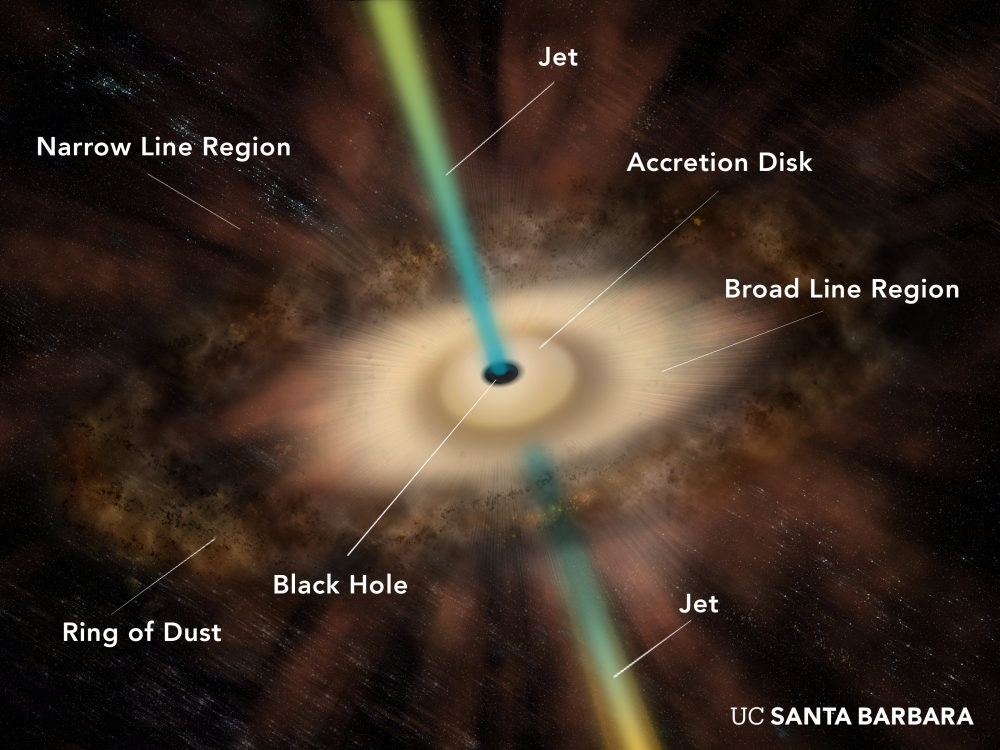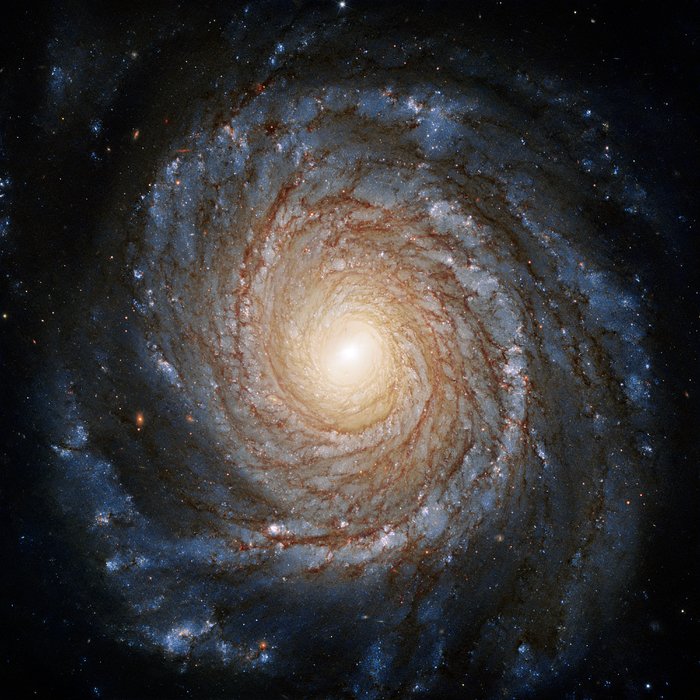
At the center of certain galaxies are objects of such tremendous brightness they outshine the rest of their galaxy by four orders of magnitude. Our understanding of these active galactic nuclei has progressed by leaps and bounds over the past several decades, though recently debate has centered on the identity of some of these objects.
Now, a team of researchers has settled some questions and exposed exciting new findings about these cosmic phenomena. Their results appear in the Monthly Notices of the Royal Astronomical Society.
Quasars, the most powerful active galactic nuclei, shine like lighthouses from their home galaxies. These beams are powered by supermassive black holes millions to billions of times the mass of the sun. “The [radius of this] black hole is 1/10,000th of the distance just to our nearest star, and yet it can produce the power of 10,000 entire galaxies,” said coauthor Robert Antonucci, a physics professor at UC Santa Barbara.
The gas around these black holes spins so fast that the color of the light it emits is stretched out. The material approaching us appears bluer, while receding gas appears redder. This stretches the normally sharp spikes in the light spectra into broad peaks.
The radiation from these systems also energizes distant gas clouds, which are less dense. Because these clouds rotate more slowly, the peaks in their light emission stay sharp. And because they are less dense, the atoms have enough time to make slower transitions between energy states without interference from neighboring atoms, so scientists see additional spikes that are due to heat rather than radiation.
A dim quasar is called a Seyfert galaxy, and the debate stems from the distinction between the two types of Seyfert galaxies. Type I galaxies produce both of these spectra, but the light from type II galaxies is missing the broad peaks. Before they knew about the black holes at the center, scientists had thought the two were different entities, and were puzzled over what could be powering them.

The nucleus of a Seyfert galaxy.
Photo Credit: MATT PERKO
Antonucci had proposed that they were actually the same objects, simply seen from different perspectives. Namely, that when the broad regions were missing from the spectra, it was because we were looking at the systems side-on, and a ring of dust was obscuring the inner part of the nucleus from our view.
Antonucci noticed that, unlike normal starlight, the light from Seyfert II galaxies tended to slightly favor one polarization, suggesting some of it had reflected our way, like sunlight off the surface of a lake. The polarization suggested that these photons had originated near the center of the black hole and traveled along the jets of high-energy matter that stream away from its poles.
By filtering out everything except this polarization, Antonucci was able to peer into the center of the obscured object, and he found the missing broad spectra. This confirmed that there was matter swirling around the black hole emitting broad bands of light, only to have most of this blocked by the surrounding ring of dust. The two types of Seyfert galaxies were, in fact, one class of objects.
Disagreement, Answers and New Questions
Twenty or so years ago, a group of scientists suggested that some galaxies actually may not emit these broad lines, calling them “true Seyfert II galaxies.” Using x-ray surveys, they found one called NGC 3147 that had neither a dust ring nor the broad emission lines. Proponents claimed that this galaxy must be one of these objects.
Scientists in the two camps decided to work together to resolve the issue, posing the question in a bid for a slot on the Hubble Space Telescope’s busy schedule. It intrigued the scientists managing Hubble enough that they granted the team an hour of the observatory’s time. An hour was all they needed.

The galaxy NGC 3147 is at the center of the Seyfert debate.
Photo Credit: ESA/HUBBLE & NASA, A. RIESS ET AL.
The team zoomed in on the center of NGC 3147 and found the broad line region. The object was so dim that the surrounding starlight had overwhelmed this feature. After two decades of debate, the idea of “true Seyfert IIs” seems to have finally been laid to rest.
In Antonucci’s opinion, this is a true triumph of the scientific method. The virtue of science is that it eventually corrects itself. “What’s most important to astronomers is pruning this dead branch,” he said.
What’s more, the team also discovered a few new features, including that NGC 3147’s broad line spectrum was stretched far more than most of them had expected. “That means the region producing the emission lines is in fact much closer to the black hole than normal,” Antonucci said. This did, however, match the predictions of one of Antonucci’s coauthors, Ari Laor at the the Technion in Israel.
The shape of this part of the spectrum also shows clear evidence of the effects of both special and general relativity. However, Antonucci is quick to point out that scores of other experiments have already established the validity of these theories.
Curiously, the researchers also found evidence of a hot, glowing accretion disk despite the fact that matter is only trickling into NGC 3147’s black hole. “According to our best theory,there shouldn’t be enough friction to convert the gravitational in-fall energy into heat,” Antonucci explained.
Hubble has granted the group roughly six hours of additional time on the telescope to follow up their observations. They plan to use this time to further probe the center of NGC 3147 in greater detail. Hopefully a closer look will help suss out the answers to this new set of questions.



